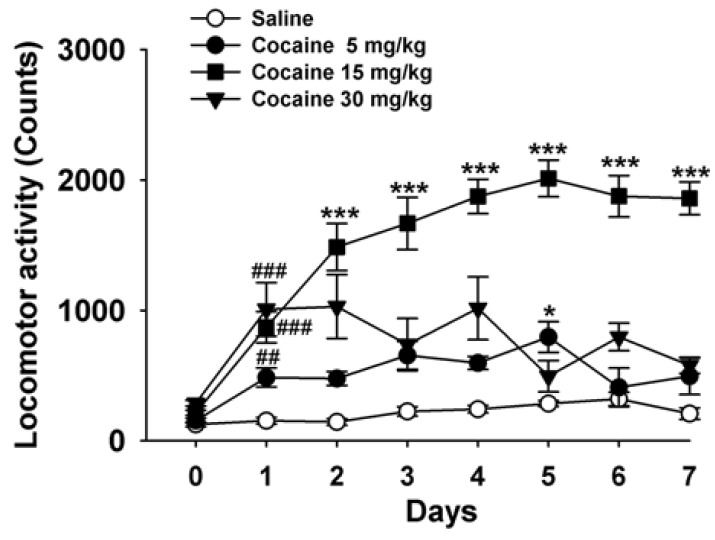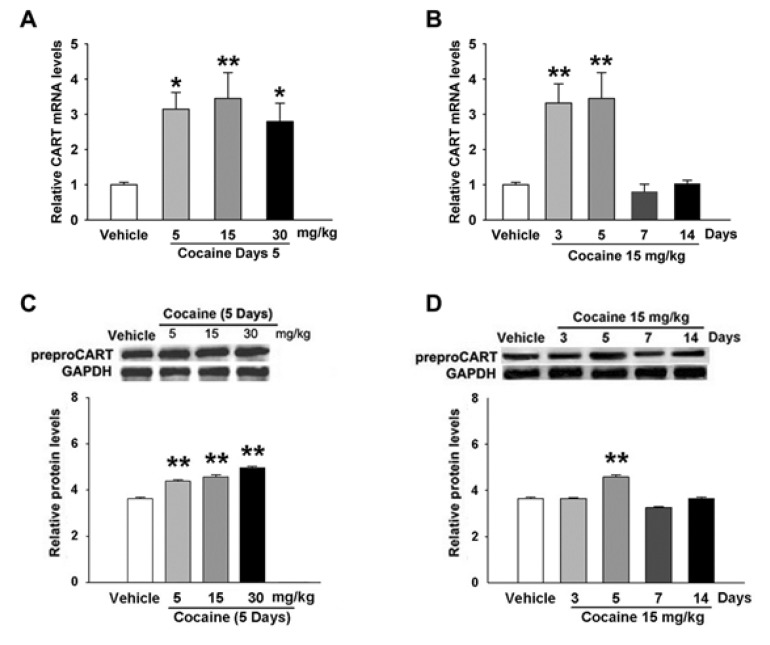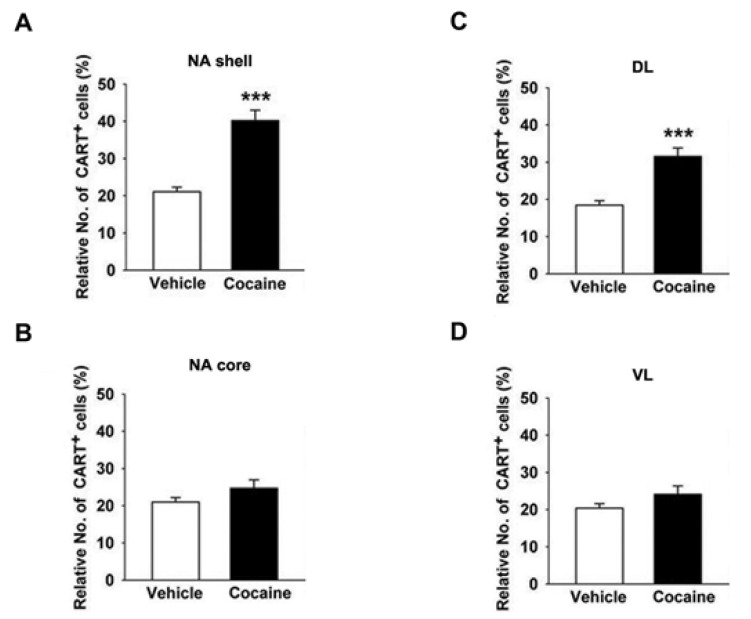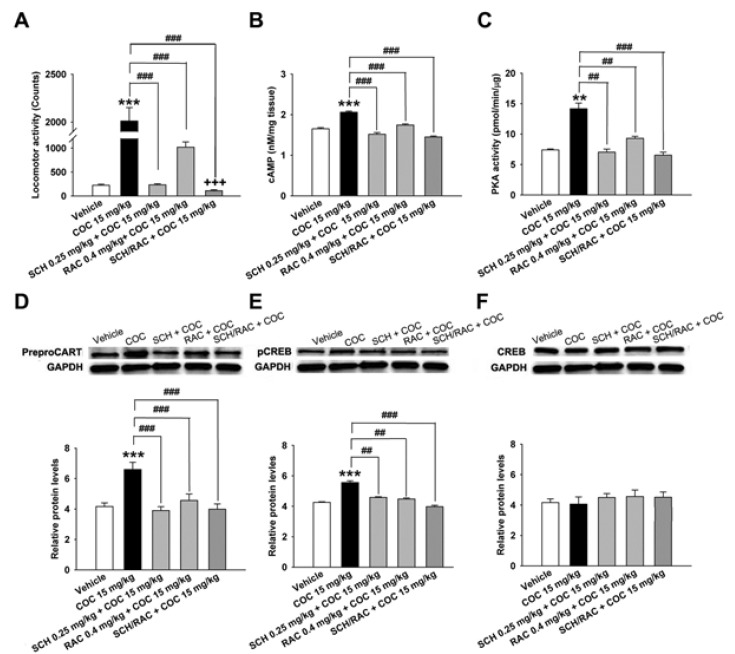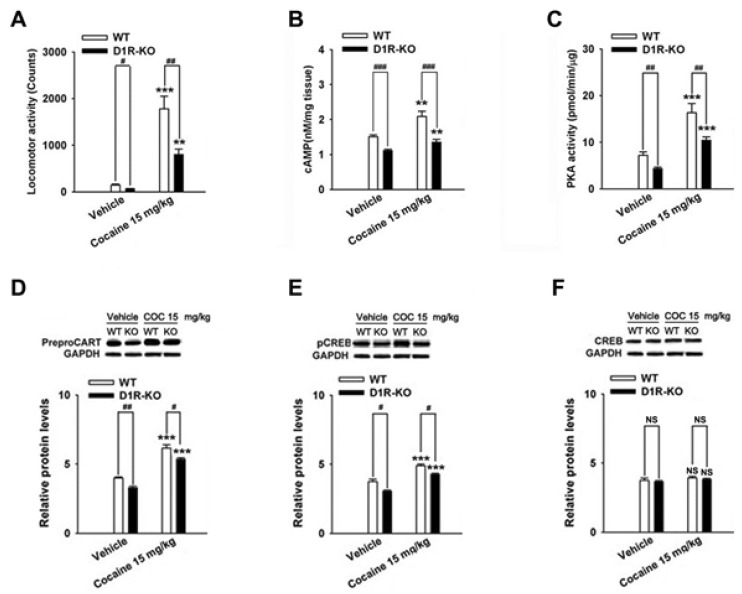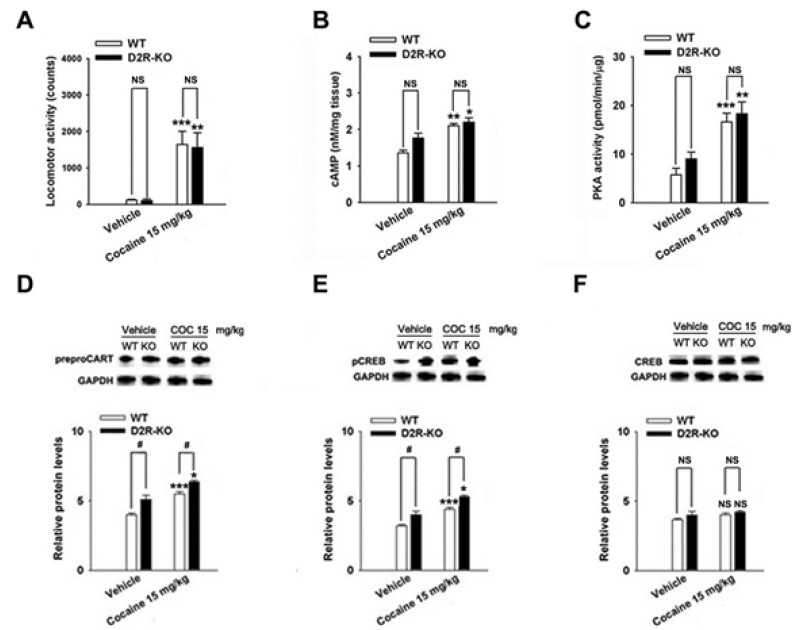Korean J Physiol Pharmacol.
2015 Mar;19(2):89-97. 10.4196/kjpp.2015.19.2.89.
Predominant D1 Receptors Involvement in the Over-expression of CART Peptides after Repeated Cocaine Administration
- Affiliations
-
- 1Department of Pathophysiology, College of Medicine, Nanchang University, Jiangxi 330006 China.
- 2Department of Pharmacy, College of Pharmacy, Chungbuk National University, Cheongju 361-763, Korea. kiwan@chungbuk.ac.kr
- KMID: 2285559
- DOI: http://doi.org/10.4196/kjpp.2015.19.2.89
Abstract
- The aim of this study was to investigate the involvement of dopaminergic receptors (DR) in behavioral sensitization, as measured by locomotor activity, and the over-expression of cocaine- and amphetamine-regulated transcript (CART) peptides after repeated administration of cocaine in mice. Repeated administrations of cocaine induced behavioral sensitization and CART over-expression in mice. The levels of striatal CART mRNA were significantly increased on the 3rd day. CART peptides were over-expressed on the 5th day in the striata of behaviorally sensitized mice. A higher proportion of CART+ cells in the cocaine-treated mice were present in the nucleus accumbens (NAc) shell than in the dorsolateral (DL) part of caudate putamen (CP). The concomitant administration of both D1R and D2R antagonists, SCH 23390 (D1R selective) and raclopride (D2R selective), blocked cocaine induced-behavioral sensitization, CART over-expression, and cyclic adenosine 5'-monophosphate (cAMP)/protein kinase A (PKA)/phospho-cAMP response element-binding protein (pCREB) signal pathways. SCH 23390 more predominantly inhibited the locomotor activity, CART over-expression, pCREB and PKA activity than raclopride. Cocaine induced-behavioral sensitization was also attenuated in the both D1R and D2R knockout (KO) mice, respectively. CART over-expression and activated cAMP/PKA/pCREB signal pathways were inhibited in the D1R-KO mice, but not in the D2R-KO mice. It is suggested that behavioral sensitization, CART over-expression and activated cAMP/PKA/pCREB signal pathways induced by repeated administration of cocaine could be more predominantly mediated by D1R.
Keyword
MeSH Terms
Figure
Reference
-
1. McGregor IS, Atrens DM, Jackson DM. Cocaine facilitation of prefrontal cortex self-stimulation: a microstructural and pharmacological analysis. Psychopharmacology (Berl). 1992; 106:239–247. PMID: 1312730.
Article2. Kuribara H. Modification of cocaine sensitization by dopamine D1 and D2 receptor antagonists in terms of ambulation in mice. Pharmacol Biochem Behav. 1995; 51:799–805. PMID: 7675862.
Article3. Nazarian A, Russo SJ, Festa ED, Kraish M, Quinones-Jenab V. The role of D1 and D2 receptors in the cocaine conditioned place preference of male and female rats. Brain Res Bull. 2004; 63:295–299. PMID: 15196654.
Article4. Woolverton WL, Ranaldi R. Comparison of the reinforcing efficacy of two dopamine D2-like receptor agonists in rhesus monkeys using a progressive-ratio schedule of reinforcement. Pharmacol Biochem Behav. 2002; 72:803–809. PMID: 12062569.
Article5. Singh VP, Singh N, Jaggi AS. A review on renal toxicity profile of common abusive drugs. Korean J Physiol Pharmacol. 2013; 17:347–357. PMID: 23946695.
Article6. Bertran-Gonzalez J, Bosch C, Maroteaux M, Matamales M, HerveD , Valjent E, Girault JA. Opposing patterns of signaling activation in dopamine D1 and D2 receptor-expressing striatal neurons in response to cocaine and haloperidol. J Neurosci. 2008; 28:5671–5685. PMID: 18509028.
Article7. Luo Z, Volkow ND, Heintz N, Pan Y, Du C. Acute cocaine induces fast activation of D1 receptor and progressive deactivation of D2 receptor striatal neurons: in vivo optical microprobe [Ca2+]i imaging. J Neurosci. 2011; 31:13180–13190. PMID: 21917801.8. Gao J, Li Y, Zhu N, Brimijoin S, Sui N. Roles of dopaminergic innervation of nucleus accumbens shell and dorsolateral caudate-putamen in cue-induced morphine seeking after prolonged abstinence and the underlying D1- and D2-like receptor mechanisms in rats. J Psychopharmacol. 2013; 27:181–191. PMID: 23151613.
Article9. Capper-Loup C, Canales JJ, Kadaba N, Graybiel AM. Concurrent activation of dopamine D1 and D2 receptors is required to evoke neural and behavioral phenotypes of cocaine sensitization. J Neurosci. 2002; 22:6218–6227. PMID: 12122080.10. Drago J, Gerfen CR, Westphal H, Steiner H. D1 dopamine receptor-deficient mouse: cocaine-induced regulation of immediate-early gene and substance P expression in the striatum. Neuroscience. 1996; 74:813–823. PMID: 8884777.
Article11. Kim S, Shin JK, Yoon HS, Kim JH. Blockade of ERK Phosphorylation in the Nucleus Accumbens Inhibits the Expression of Cocaine-induced Behavioral Sensitization in Rats. Korean J Physiol Pharmacol. 2011; 15:389–395. PMID: 22359477.
Article12. Chausmer AL, Katz JL. The role of D2-like dopamine receptors in the locomotor stimulant effects of cocaine in mice. Psychopharmacology (Berl). 2001; 155:69–77. PMID: 11374338.
Article13. Jaworski JN, Jones DC. The role of CART in the reward/reinforcing properties of psychostimulants. Peptides. 2006; 27:1993–2004. PMID: 16766084.
Article14. Yoo SB, Lee S, Lee JY, Kim BT, Lee JH, Jahng JW. cAMP/PKA agonist restores the fasting-induced down-regulation of nNOS expression in the paraventricular nucleus. Korean J Physiol Pharmacol. 2012; 16:333–337. PMID: 23118557.
Article15. Douglass J, McKinzie AA, Couceyro P. PCR differential display identifies a rat brain mRNA that is transcriptionally regulated by cocaine and amphetamine. J Neurosci. 1995; 15:2471–2481. PMID: 7891182.
Article16. Moffett MC, Song J, Kuhar MJ. CART peptide inhibits locomotor activity induced by simultaneous stimulation of D1 and D2 receptors, but not by stimulation of individual dopamine receptors. Synapse. 2011; 65:1–7. PMID: 20506412.
Article17. Lee S, Kim Y, Li E, Park S. Ghrelin protects spinal cord motoneurons against chronic glutamate excitotoxicity by inhibiting microglial activation. Korean J Physiol Pharmacol. 2012; 16:43–48. PMID: 22416219.
Article18. Hunter RG, Jones D, Vicentic A, Hue G, Rye D, Kuhar MJ. Regulation of CART mRNA in the rat nucleus accumbens via D3 dopamine receptors. Neuropharmacology. 2006; 50:858–864. PMID: 16458333.
Article19. Salinas A, Wilde JD, Maldve RE. Ethanol enhancement of cocaine- and amphetamine-regulated transcript mRNA and peptide expression in the nucleus accumbens. J Neurochem. 2006; 97:408–415. PMID: 16539670.
Article20. Jones DC, Kuhar MJ. Cocaine-amphetamine-regulated transcript expression in the rat nucleus accumbens is regulated by adenylyl cyclase and the cyclic adenosine 5'-monophosphate/protein kinase a second messenger system. J Pharmacol Exp Ther. 2006; 317:454–461. PMID: 16322355.
Article21. Jones DC, Kuhar MJ. CART receptor binding in primary cell cultures of the rat nucleus accumbens. Synapse. 2008; 62:122–127. PMID: 18000808.
Article22. Lakatos A, Dominguez G, Kuhar MJ. CART promoter CRE site binds phosphorylated CREB. Brain Res Mol Brain Res. 2002; 104:81–85. PMID: 12117553.
Article23. Tadokoro S, Kuribara H. Reverse tolerance to the ambulation-increasing effect of methamphetamine in mice as an animal model of amphetamine-psychosis. Psychopharmacol Bull. 1986; 22:757–762. PMID: 3797581.24. Hu Z, Park KS, Han JY, Jang CG, Oh S, Kim HC, Yang CH, Kim EJ, Oh KW. Markers in morphine- and cocaine-addicted animals. Biomol Ther. 2011; 19:45–51.
Article25. Franklin KB, Paxinos G. The mouse brain in stereotaxic coordinates. San Diego: Academic Press;1997.26. Tanegashima K, Okamoto S, Nakayama Y, Taya C, Shitara H, Ishii R, Yonekawa H, Minokoshi Y, Hara T. CXCL14 deficiency in mice attenuates obesity and inhibits feeding behavior in a novel environment. PLoS One. 2010; 5:e10321. PMID: 20428232.
Article27. Morio A, Ujike H, Nomura A, Tanaka Y, Morita Y, Otani K, Kishimoto M, Harano M, Inada T, Komiyama T, Yamada M, Sekine Y, Iwata N, Iyo M, Sora I, Ozaki N, Kuroda S. No association between CART (cocaine- and amphetamine-regulated transcript) gene and methamphetamine dependence. Ann N Y Acad Sci. 2006; 1074:411–417. PMID: 17105939.
Article28. Marie-Claire C, Laurendeau I, Canestrelli C, Courtin C, Vidaud M, Roques B, Noble F. Fos but not Cart (cocaine and amphetamine regulated transcript) is overexpressed by several drugs of abuse: a comparative study using real-time quantitative polymerase chain reaction in rat brain. Neurosci Lett. 2003; 345:77–80. PMID: 12821175.
Article29. Roh MS, Cui FJ, Ahn YM, Kang UG. Up-regulation of cocaine- and amphetamine-regulated transcript (CART) in the rat nucleus accumbens after repeated electroconvulsive shock. Neurosci Res. 2009; 65:210–213. PMID: 19577595.
Article30. Germano CM, de Castro M, Rorato R, Laguna MT, Antunes-Rodrigues J, Elias CF, Elias LL. Time course effects of adrenalectomy and food intake on cocaine- and amphetamine-regulated transcript expression in the hypothalamus. Brain Res. 2007; 1166:55–64. PMID: 17669377.
Article31. Jang HS, Kim JY, Kim SH, Lee MG. Role of dopamine receptors on electroencephalographic changes produced by repetitive apomorphine treatments in rats. Korean J Physiol Pharmacol. 2009; 13:147–151. PMID: 19885030.
Article32. Hubert GW, Kuhar MJ. Colocalization of CART peptide with prodynorphin and dopamine D1 receptors in the rat nucleus accumbens. Neuropeptides. 2006; 40:409–415. PMID: 17064765.
Article33. Jaworski JN, Vicentic A, Hunter RG, Kimmel HL, Kuhar MJ. CART peptides are modulators of mesolimbic dopamine and psychostimulants. Life Sci. 2003; 73:741–747. PMID: 12801595.
Article34. Couceyro PR, Evans C, McKinzie A, Mitchell D, Dube M, Hagshenas L, White FJ, Douglass J, Richards WG, Bannon AW. Cocaine- and amphetamine-regulated transcript (CART) peptides modulate the locomotor and motivational properties of psychostimulants. J Pharmacol Exp Ther. 2005; 315:1091–1100. PMID: 16099925.
Article35. Valjent E, Corvol JC, Pages C, Besson MJ, Maldonado R, Caboche J. Involvement of the extracellular signal-regulated kinase cascade for cocaine-rewarding properties. J Neurosci. 2000; 20:8701–8709. PMID: 11102476.
Article36. Rogge GA, Jones DC, Green T, Nestler E, Kuhar MJ. Regulation of CART peptide expression by CREB in the rat nucleus accumbens in vivo. Brain Res. 2009; 1251:42–52. PMID: 19046951.
Article37. Shi X, McGinty JF. D1 and D2 dopamine receptors differentially mediate the activation of phosphoproteins in the striatum of amphetamine-sensitized rats. Psychopharmacology (Berl). 2011; 214:653–663. PMID: 21057772.
Article38. Guan X, Tao J, Li S. Dopamine D1 receptor, but not dopamine D2 receptor, is a critical regulator for acute cocaine-enhanced gene expression. Neurol Res. 2009; 31:17–22. PMID: 19228458.
Article39. Welter M, Vallone D, Samad TA, Meziane H, Usiello A, Borrelli E. Absence of dopamine D2 receptors unmasks an inhibitory control over the brain circuitries activated by cocaine. Proc Natl Acad Sci U S A. 2007; 104:6840–6845. PMID: 17426149.
Article40. Rouge-Pont F, Usiello A, Benoit-Marand M, Gonon F, Piazza PV, Borrelli E. Changes in extracellular dopamine induced by morphine and cocaine: crucial control by D2 receptors. J Neurosci. 2002; 22:3293–3301. PMID: 11943831.41. Kelly MA, Rubinstein M, Asa SL, Zhang G, Saez C, Bunzow JR, Allen RG, Hnasko R, Ben-Jonathan N, Grandy DK, Low MJ. Pituitary lactotroph hyperplasia and chronic hyperprolactinemia in dopamine D2receptor-deficient mice. Neuron. 1997; 19:103–113. PMID: 9247267.
- Full Text Links
- Actions
-
Cited
- CITED
-
- Close
- Share
- Similar articles
-
- Interactions of Dopamine D1 and N-methyl-D-Aspartate Receptors are Required for Acute Cocaine-Evoked Nitric Oxide Efflux in the Dorsal Striatum
- Cocaine-Induced Behavioral Sensitization in Mice: Effects of Microinjection of Dopamine D2 Receptor Antagonist into the Nucleus Accumbens
- Amperozide decreases cocaine-induced increase in behavior and immediate early gene expression in the dorsal striatum
- Cocaine- and Amphetamine-Regulated Transcript (CART) Peptide Plays Critical Role in Psychostimulant-Induced Depression
- Ritanserin, a 5HT2/1C receptor antagonist, does not block cocaine-induced behavioral alterations and zif268 mRNA expression in the striatum of the rats

